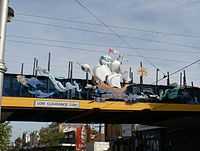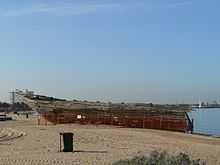Lady of St Kilda
 Sketch of the Lady of St Kilda by Jno. R. Browning c 1890 | |
| Career (England) | |
|---|---|
| Name: | Lady of St Kilda |
| Owner: | Sir Thomas Dyke Acland, 10th Baronet |
| Builder: | Robert Newman |
| Launched: | 1834 at Dartmouth, Devon, England |
| Fate: | Wrecked November, 1844 |
| General characteristics | |
| Tonnage: | 139 tons |
The Lady of St Kilda was a schooner which served from 1834 before being shipwrecked off Tahiti shortly after 1843.[1]
It is notable for its cultural importance to Melbourne, Australia where it was moored in the 1840s. Several places in bayside Melbourne, including the suburb of St Kilda, and the former municipality the City of St Kilda (now Port Phillip) take its name from the ship, its owner and captain.
History
The schooner was bought by Sir Thomas Dyke Acland (a member of a prominent British political family) in 1834. Built in Dartmouth, Devon, England to carry fruit from the Mediterranean to London it was named Lady of St Kilda for the island of St Kilda in the Outer Hebrides of Scotland[2] to commemorate a visit to the island by his wife, Lydia, in 1810. Acland had named the vessel after Lady Rachel Erskine Grange, who in 1734 was imprisoned by her husband and a group of Jacobite Noblemen on the St Kilda archipelago in Scotland for 17 years. The Lady of St Kilda is the only woman in Scotland known to have had three funerals Rachel Erskine Grange is reported by Tom Steele to have been a bad tempered woman, who overheard her husband James Erskine of Grange plotting a rebellion in 1731. After she threatened to expose the conspirators, the Jacobite nobles who were assembled at her house in Edinburgh decided to imprison her and pretend she was dead. Her fake funeral was held the next day. Rachel was first taken to the Isle of Heisker, off North Uist, then to St Kilda where she was a virtual prisoner, for eight years, from 1734 till 1742.She was then brought to Uist, then to Assynt and then to Skye, where she learned how to spin wool. While on Skye, Rachel managed to smuggle a letter to her cousin, the Lord Advocate, who sent the Navy to search Skye for her. The navy found no trace of Rachel on Skye, however, and her captors, The Macdonalds had her taken back to Uist and then to the Vaternish peninsula where she died in 1745. Her captors were still afraid their false imprisonment of her would be discovered, so they held a second fake funeral for Rachel and buried a second fake coffin at Duirinish, while her body was interred at Trumpan, above Ardmore bay, on the Isle of Skye. Rachel stayed longer on the isle of Hirta, than any other outsider, except for the Ministers who were sent to Hirta, AKA St Kilda, the most remote of the Western Hebridean islands.[3][4][5]
Thomas Acland sold the vessel in 1840 to Jonathan Cundy Pope of Plymouth. The vessel was again used as a trading vessel and sailed for Port Phillip Bay in Melbourne in February 1841. The vessel was usually moored off the foreshore, which was soon known as "the St. Kilda foreshore."[1]
In July 1842, the Lady of St Kilda sailed for Canton.
Legacy
The ship's legacy includes the naming of the town (and later city) St Kilda by the former ship master Lieutenant James Ross Lawrence.
One of the town's main streets, Acland Street, was named after the former owner Sir Thomas Dyke Acland.
There is a mural of the Lady of St Kilda on the Sandringham Railway Line overpass at Balaclava, Victoria commissioned by the City of Port Phillip.
Despite its huge popularity, a 2006 art installation depicting a mock shipwreck at St Kilda Main Beach was later disassembled by the City of Port Phillip because of public safety concerns despite calls to keep it.
A scale model of the Lady of St Kilda by retired boatbuilder John MacAulay is now exhibited in the Kilda Cruises Centre on the Isle of Harris in Scotland. A book describing her complete history will be available soon.
-

Lady of St Kilda mural on the railway overpass over the main shopping strip on Carlisle Street, Balaclava
-

Lady of St Kilda sculpture at St Kilda main beach (now removed)
-
Memorial plaque to first Crown land sale in St Kilda to Lieut James Ross Lawrence, Captain of the schooner Lady of St Kilda.
References
- ↑ 1.0 1.1 Lady of St Kilda
- ↑ Shawfactor. "Local history of St. Kilda".
- ↑ UN World Conservation Monitoring Centre
- ↑ The ST KILDA HISTORICAL SOCIETY SERIES, 'A Place of Sensuous Resort', Part 15, Summerland Mansions, Naming St Kilda
- ↑ ST KILDA HISTORICAL SOCIETY SERIES, 'A Place of Sensuous Resort', Part 15, Summerland Mansions, Naming St Kilda.
